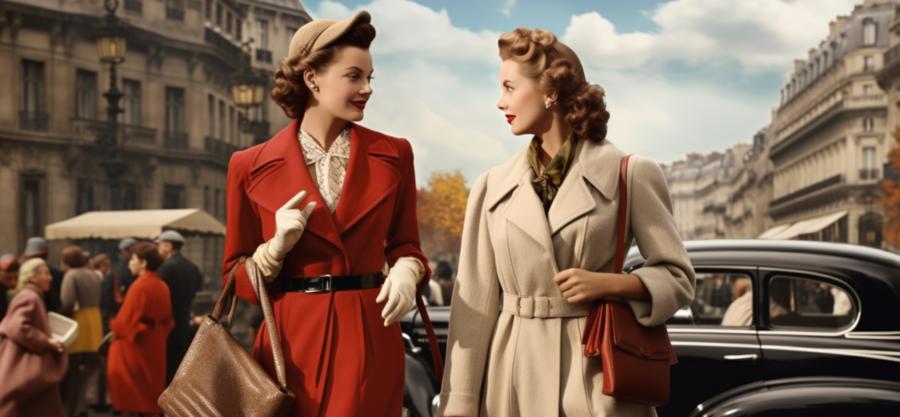New Look Emerges: Post-WWII Paris Fashion

Paris Reclaims Its Fashion Capital Crown
As the smoky haze of World War II began to dissipate, the city of light, Paris, once again emerged as the anointed world capital of all things fashionable and fabulous. With couturiers desperately stitching away like busy bees to mend the torn fabric of society, a fresh and rejuvenated Paris fashion scene bloomed from the ashes, its infectious joie de vivre spreading like a particularly potent strain of influenza.The Birth of the New Look
It was in this effervescent post-war milieu that the legendary Christian Dior, the mad hatter of Paris fashion, launched his eponymous fashion house, forever changing the course of women's fashion. In 1947, Dior unveiled his groundbreaking first collection, dubbed "La Ligne Corolle" in the French press, but soon to be known the world over as the "New Look."The New Look was characterized by a return to the feminine hourglass figure, with nipped-in waists and full, flowing skirts. No longer must women don the utilitarian styles of the war years; they were now free to envelop themselves in the voluptuous embrace of petticoats and peplums. The New Look was not so much a fashion statement as it was a rallying cry, a vibrant declaration of the rebirth of Parisian beauty and sophistication.
A Couture Comeback
Of course, Dior was not the only couturier making waves in the post-war Paris fashion scene. Designers such as Coco Chanel, Hubert de Givenchy, and Pierre Balmain all contributed to the renaissance of haute couture. The air was thick with the scent of ambition and hairspray as designers vied for the coveted title of the most influential fashion house in the world.- Coco Chanel, the grand dame of fashion herself, returned from her wartime Swiss exile and reopened her legendary fashion house in 1954. While her tweed suits and little black dresses may not have been as ostentatious as Dior's creations, they exuded a timeless elegance that continues to captivate fashionistas to this very day.
- Hubert de Givenchy, a young upstart who had apprenticed under none other than Dior himself, founded his own fashion house in 1952. With his emphasis on simplicity and elegance, Givenchy breathed new life into the Paris fashion scene, attracting a devoted cadre of celebrity clients, including Audrey Hepburn, who embodied the house's chic, understated style.
- Pierre Balmain, another disciple of Dior, founded his eponymous fashion house in 1945. With his penchant for luxurious fabrics and intricate embroidery, Balmain's creations were the epitome of opulence and glamour, a testament to the resurgence of Paris as the glittering capital of couture.
Innovation, or Fashion Faux Pas?
Not everyone, however, was captivated by the extravagant styles of the New Look. Critics abounded, with some accusing the fashion houses of being out of touch with the realities of post-war Europe. After all, rationing was still in place, and a single Dior outfit could use up to 80 meters of fabric! And yet, the clamor for these decadent designs was undeniable, with women around the world clamoring for a taste of Parisian glamour, even if it meant accepting the incongruity between their lavish wardrobes and their still-scarred cities.Changing of the Guard
Alas, as with all things fabulous, the New Look could not reign supreme forever. As the 1960s dawned, so too did a new age of fashion, one characterized by youthful rebellion and an insatiable thirst for change. It was in this tumultuous climate that designers such as Yves Saint Laurent and André Courrèges rose to prominence, their innovative designs heralding a new era in fashion.- Yves Saint Laurent, who had been handpicked by Dior as his successor, took the helm of the fashion house after Dior's untimely death in 1957. With his groundbreaking "Trapeze" collection, Saint Laurent proved that he was not content to simply follow in Dior's footsteps. Instead, he forged his own path, redefining the very concept of fashion with his groundbreaking designs such as the Mondrian dress and the "Le Smoking" tuxedo for women.
- André Courrèges, another former Dior apprentice, made his own mark on the fashion world with his revolutionary "Space Age" designs. Out with the old and in with the new, Courrèges traded in the voluminous skirts and sculpted silhouettes of the New Look for sleek, minimalist designs that epitomized the spirit of the 1960s, a brave new world in which Paris fashion continued to reign supreme.
Article kindly provided by foreverinfashion.org
Latest Articles
- Style That Works With Your Body, Not Against It
- Fashion Tourism on Wheels: Curated Shopping Routes Led by Chauffeur Guides
- The Charm of Certainty in a World of Indecision
- Can an Everyday T-Shirt Be Turned into a Modern Heirloom?
- Color, Ceremony, and the Psychology of Celebration
- Styling Graphic T-Shirts for Different Body Types
- Getting Kids to Wear Their Hats Without a Bribe or a Meltdown
- Mastering the Art of Being the Unnoticed Photographer
- Quiet Sportswear Moves Loudly
- Fashion's Most Misunderstood Color Is Brown
- Weight Matters When Cotton Gets Real
- SKU's Out for Summer: Why Your Warehouse Is Melting Down
- Ink as Accessory - How Tattoos Are Replacing Jewelry in Modern Style
- Decoding the Y2K Aesthetic with Style and Sanity
- Accessories
- Jewellery
- Footwear
- Skirts and Dresses
- Shirts and Blouses
- Beauty and Makeup
- Fashion Photography
- Sustainable Fashion
- Street Style
- Fashion History
- Fashion Business
- Fashion Styling
- Fashion Events
- Plus-Size Fashion
- Men's Fashion
- Women's Fashion
- Fashion Blogging
- Fashion Trends
- Fashion Retailers
- Fashion Tips and Advice
- Fashion Business Startups
- Fashion Around the World
- Lingerie
- Sportswear
- Weddings

